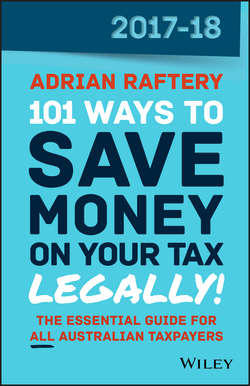Читать книгу 101 Ways to Save Money on Your Tax – Legally! 2017-2018 - Adrian Raftery - Страница 9
На сайте Литреса книга снята с продажи.
PART I YOU AND YOUR FAMILY 3 DEPENDANT (INVALID AND CARER) TAX OFFSET
ОглавлениеThe dependant (invalid and carer) tax offset (DICTO) is only available to taxpayers who maintain a dependant who is genuinely unable to work due to carer obligation or disability.
TAX FACT
The DICTO has consolidated the following tax offsets:
•invalid spouse
•carer spouse
•housekeeper
•housekeeper (with child)
•child housekeeper
•child housekeeper (with child)
•invalid relative
•parent/parent-in-law.
The ATO may deem you eligible for the DICTO if the following applies:
•you contribute to the maintenance of your spouse, your parent (or your parent's spouse), your child (aged 16 or over) or siblings (aged 16 or over)
•your dependant was being paid either:
— a disability support, a special needs disability support or an invalidity service pension
— a carer allowance for a child or sibling aged 16 or over
•your adjusted taxable income as the primary income earner was $100 000 or less
•your dependant's adjusted taxable income was less than $10 790
•you and your dependant were Australian residents (not just visiting).
If you satisfy the above and your dependant's adjusted taxable income was $285 or less and you maintained him or her for the whole year, you can claim the maximum dependant (invalid and carer) tax offset of $2627.
PITFALL
The DICTO is reduced by $1 for every $4 that your dependant's adjusted taxable income exceeds $282.
TIP
You may be able to receive more than one amount of DICTO if you contributed to the maintenance of more than one dependant during the year, including if you had different spouses during the year.
TAX FACT
The ATO defines your ‘adjusted taxable income' as the sum of the following amounts, less any child support that you have paid:
•taxable income
•adjusted fringe benefits
•tax-free pensions or benefits
•income from overseas not reported in your tax return
•reportable super contributions
•total net investment loss for both financial investments and rental properties.
EXAMPLE
Marlene and Saxon are married. Marlene is genuinely unable to work and has no salary or wage income. They have rental properties and a share portfolio. Saxon has also entered into a salary-sacrificing arrangement to boost his super. His taxable income is $130 000 after claiming a total net investment loss of $18 000. He has reportable super contributions of $17 000.
Saxon's adjusted taxable income is $165 000 ($130 000 + $18 000 + $17 000). As Saxon's adjusted taxable income is over the income threshold for this offset ($100 000) he is not eligible to claim the dependant (invalid and carer) tax offset.
